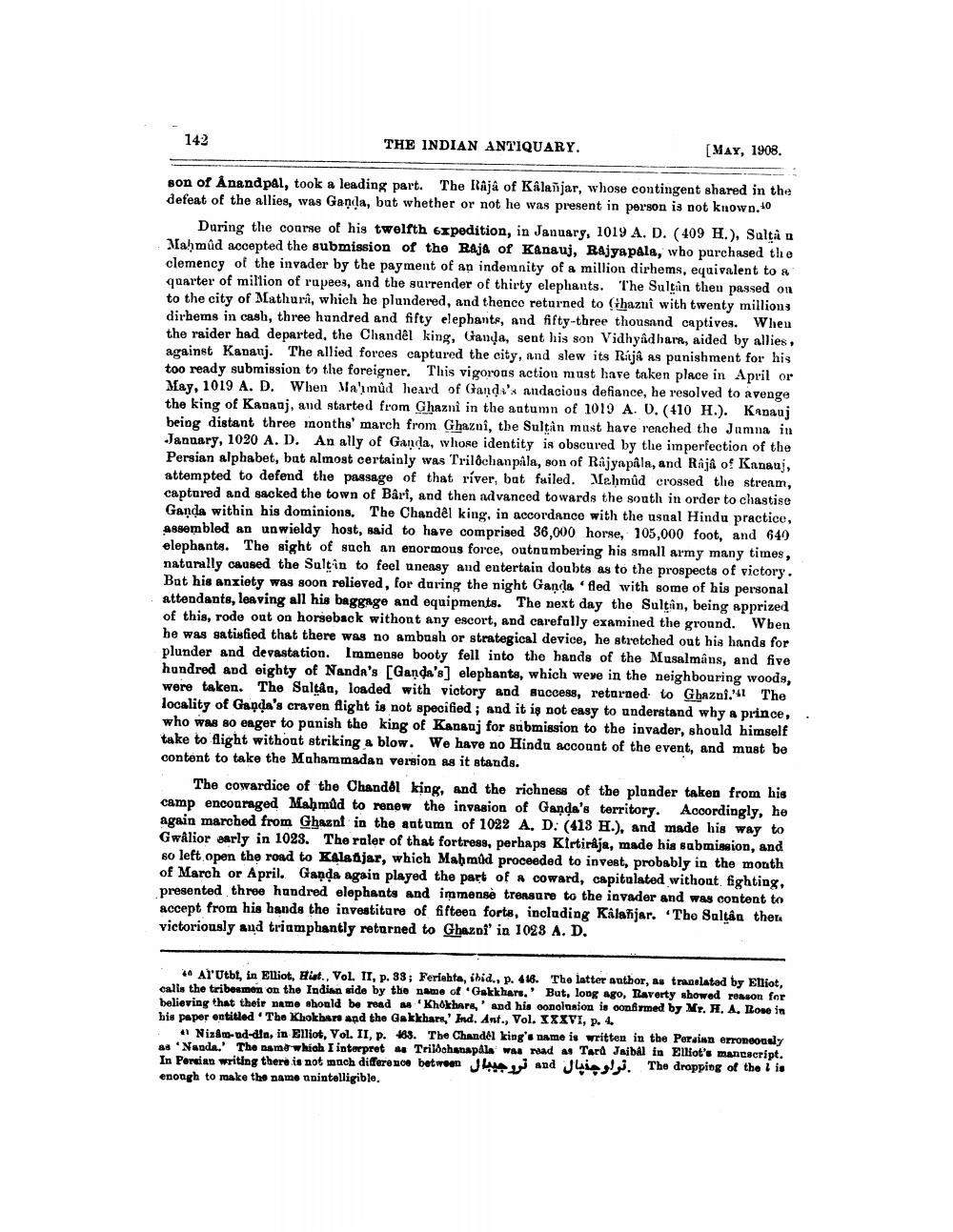________________
142
THE INDIAN ANTIQUARY.
[May, 1908.
son of Anandpal, took a leading part. The Raja of Kalañjar, whose contingent shared in the defeat of the allies, was Ganıla, but whether or not he was present in person is not known.co
During the course of his twelfth expedition, in January, 1019 A. D. (409 H.), Sultan Mahmúd accepted the submission of the Raja of Kanauj, Rajyapala, who purchased the clemency of the invader by the payment of an indemnity of a million dirhems, equivalent to a quarter of million of rupees, and the surrender of thirty elephants. The Sultan then passed on to the city of Mathura, which he plundered, and thence returned to Ghazni with twenty millions dirhems in cash, three hundred and fifty elephants, and fifty-three thousand captives. When the raider had departed, the Chandel king, Ganda, sent his son Vidhyadhara, aided by allies, against Kananj. The allied forces captured the city, and slew its Raja as punishment for his too ready submission to the foreigner. This vigorous action must have taken place in April or May, 1019 A. D. When Valımůd heard of Ganda's andacious defiance, he resolved to avenge the king of Kapanj, and started from Ghazni in the autumn of 1019 A. 0. (410 H.). Kapauj being distant three months' march from Ghaznî, the Sultan must have renched the Jamna in January, 1020 A. D. An ally of Ganda, whose identity is obscured by the imperfection of the Persian alphabet, bat almost certainly was Trilôchanpåla, son of Rajyapâla, and Raja of Kanauj, attempted to defend the passage of that river, but fuiled. Mehmûd crossed the stream, captured and sacked the town of Bari, and then advanced towards the south in order to chastise Ganda within his dominions. The Chandel king, in accordance with the usual Hindu practice, assembled an unwieldy host, said to have comprised 36,000 horse, 105,000 foot, and 649 elephants. The sight of such an enormous force, outnumbering his small army many times, naturally caused the Sultin to feel uneasy and entertain doubts as to the prospects of victory. Bat his anxiety was soon relieved, for during the night Ganda 'fled with some of his personal attendants, leaving all his baggage and equipments. The next day the Sultin, being apprized of this, rode out on horseback without any escort, and carefully examined the ground. When he was satisfied that there was no ambush or strategical device, he stretched out his hands for plunder and devastation. Immense booty fell into the hands of the Musalmans, and five hundred and eighty of Nanda's [Ganda's] elephants, which were in the neighbouring woods, were taken. The Sultan, loaded with victory and success, retarded to Ghazni.'41 The locality of Ganda's craven flight is not specified; and it is not easy to understand why a prince, who was so eager to panish the king of Kansaj for submission to the invader, should himself take to flight without striking a blow. We have no Hindu account of the event, and must be content to take the Muhammadan version as it stands.
The cowardice of the Chandál king, and the richness of the plunder taken from his camp encouraged Mahmúd to renew the invasion of Ganda's territory. Accordingly, he again marched from Ghaznt in the autumn of 1022 A, D: (413 H.), and made his way to Gwalior early in 1023. The ruler of that fortress, perhaps Kirtiraja, made his submission, and 80 left open the road to KAlgajar, which Mahmúd proceeded to invest, probably in the month of March or April. Ganda again played the part of a coward, capitulated without fighting, presented three hundred elephants and immense treasure to the invader and was content to accept from his hands the investiture of fifteen forts, including Kalaħjar. The Sultân thera victoriously and triumphantly returned to Ghazni' in 1028 A. D.
4 Al Utbt, in Elliot, Hist., Vol. II, p. 38; Feriehta, ihid., p. 416. The latter author, as translated by Elliot, calls the tribesmen on the Indian side by the name of "Gakkhars.' But, long ago, Raverty showed reason for believing that their name should be read as 'Khokhare, and his sonolusion is confirmed by Mr. H. A. Rose in his paper entitled 'The Khokher and the Gakkhara, Ind. Ant., Vol. XXXVI, p. 4.
Nizâm-ud-dla, in Elliot, Vol. II, p. 483. The Chandel king's name is written in the Persian erroneously Nade' The name which I interpret a Trildchenapala was mad as Tard Jabal in Elliot's mancseript. In Persian writing there is not much difference between June and Jules. The dropping of the l is enough to make the name anintelligible.




